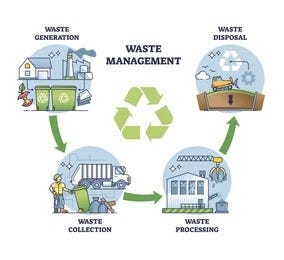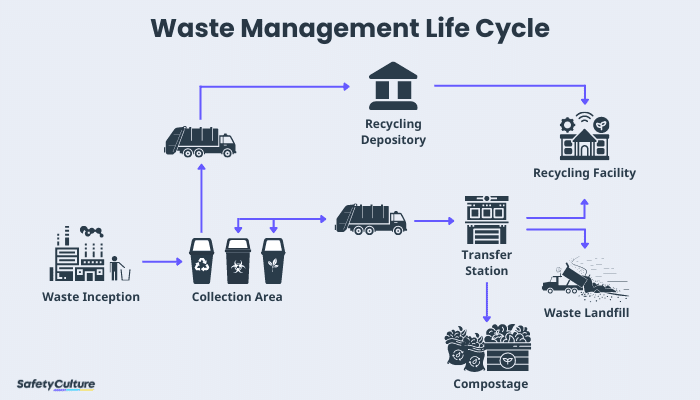Exploring Various Kinds of Waste in Modern Waste Monitoring Solution
The contemporary landscape of waste management entails navigating a complex range of waste kinds, each needing specialized handling and disposal techniques to minimize ecological impacts. Municipal strong waste, contaminated materials, electronic waste, and organic waste each existing distinctive difficulties and opportunities for source healing. Cutting-edge services such as wise waste bins and waste-to-energy modern technologies are becoming essential tools in improving performance and sustainability. Recognizing these waste kinds is essential for promoting public understanding and motivating energetic involvement in lasting methods. What techniques can effectively attend to these different sorts of waste while promoting a circular economic climate?
Municipal Solid Waste
Local strong waste, often referred to as household trash or garbage, includes a selection of thrown out products generated by household, business, and institutional sources within a district. This waste stream usually consists of products such as packaging, food scraps, yard trimmings, paper, plastics, fabrics, and thrown out home items. The management of metropolitan solid waste is a critical element of city preparation and public wellness, demanding reliable collection, transport, and disposal systems.
Reliable waste management systems are developed to minimize ecological impact while making the most of resource recovery. This typically includes a combination of strategies including landfilling, recycling, and composting. Reusing programs target materials like paper, glass, steels, and specific plastics, diverting them from landfills and reestablishing them into the production cycle. Composting organic waste, such as food scraps and lawn trimmings, not just lowers garbage dump usage yet also creates important dirt changes.
Communities need to also attend to the economic and logistical challenges related to waste management. Carrying out pay-as-you-throw systems, enhancing public recognition, and buying technology can considerably improve waste diversion rates. By incorporating these techniques, communities can promote lasting areas, reduce greenhouse gas emissions, and save natural resources.
Contaminated Materials

Efficient harmful waste administration includes numerous important actions: identification, treatment, segregation, and disposal. Partition makes sure that dangerous materials are stored independently from non-hazardous waste to protect against cross-contamination.
Regulatory frameworks, such as the Resource Conservation and Recuperation Act (RCRA) in the USA, offer standards and standards for harmful waste administration. Adherence to these policies, coupled with developments in waste treatment modern technologies, is important in alleviating the risks related to contaminated materials.
Digital Waste
Digital waste, typically referred to as e-waste, represents a swiftly expanding difficulty in waste administration systems globally. This type of waste includes discarded electronic tools and tools such as smart devices, computer systems, televisions, and various other electronic appliances. The quick speed of technological improvement, combined with decreasing product life expectancies and customer demand for the most recent gadgets, has greatly raised the volume of e-waste created each year.
E-waste is especially bothersome due to its complicated make-up, often having hazardous materials like mercury, lead, and cadmium, which present considerable ecological and health threats if not effectively taken care of. On the other hand, e-waste likewise contains beneficial products such as gold, copper, and silver, which can be recovered and reused. The dual nature of e-waste-- both useful and hazardous-- necessitates specific handling, reusing, and disposal processes.
Reliable e-waste administration entails rigid regulatory frameworks, durable collection systems, and advanced reusing innovations. Public recognition and involvement are critical, as inappropriate disposal methods, such as prohibited unloading and her comment is here informal recycling, intensify ecological contamination and carcinogen. Subsequently, improving e-waste administration practices is crucial for mitigating eco-friendly influence and recuperating useful sources in a significantly electronic globe.

Organic Waste
Organic waste, making up kitchen scraps, lawn trimmings, and farming residues, represents a significant portion of the global waste stream. This kind of waste is naturally degradable, suggesting it can be damaged down by microbes into easier organic compounds. Despite its possibility for natural decomposition, inappropriate monitoring of organic waste can bring about unfavorable ecological impacts, consisting of the discharge of greenhouse gases such as methane, which contribute to environment change.
Effective monitoring of organic waste is vital for reducing these environmental influences (recycling lives services). Composting is a commonly embraced approach, changing organic waste into nutrient-rich compost that can improve dirt wellness and farming efficiency. Additionally, anaerobic food digestion is an emerging technology that converts organic waste right into biogas, a renewable resource source, and digestate, which can be utilized as plant food
Municipalities and waste management entities need to execute durable natural waste collection and treatment programs to maximize the benefits of these procedures. Public education and learning projects can likewise play a pivotal duty in encouraging houses and businesses to different organic waste from various other sorts of waste. By prioritizing the management of organic waste, societies can reduce landfill use, lower greenhouse gas emissions, and produce important by-products for farming usage.

Ingenious Waste Management
In the realm of waste management, innovative approaches are changing how societies manage their refuse, intending for sustainability and performance. These developments encompass a series of technologies and practices that improve recycling rates, lower landfill reliance, and lower ecological effect. One popular development is the execution of clever waste bins equipped with sensing units that monitor fill degrees and optimize collection courses. This not only lowers fuel intake but additionally lessens greenhouse gas discharges.
An additional remarkable growth is the adoption of waste-to-energy (WtE) technologies. By converting non-recyclable waste right into functional energy through processes such as incineration and anaerobic digestion, WtE minimizes land fill problem and offers a renewable power source. Additionally, improvements in chemical recycling enable the break down of complex plastics right into their initial monomers, allowing my blog the production of brand-new, high-grade plastic items.
In addition, the round economic situation version is obtaining traction, stressing the design of products and systems that focus on reusability and resource effectiveness. This holistic technique encourages sectors to lessen waste generation from the outset. Through these cutting-edge methods, contemporary waste management systems are not just resolving the prompt difficulties of waste disposal but additionally leading the way for a much more sustainable future.
Final Thought
A detailed understanding of local solid waste, dangerous waste, electronic waste, and natural waste, combined with the execution of cutting-edge waste monitoring options, is important for minimizing ecological influences. Incorporating modern technologies such as smart waste containers and waste-to-energy systems can boost performance and sustainability. Efficient waste administration techniques not only foster resource recuperation however also promote public understanding and involvement, ultimately adding to the advancement of a circular economic climate.
The contemporary landscape of waste administration includes navigating a complex range of waste types, each needing specialized handling and disposal techniques to alleviate ecological effects. Municipal solid waste, harmful waste, digital waste, and organic waste each existing distinct obstacles and opportunities for source recovery.Digital waste, frequently referred to as e-waste, stands for a quickly expanding obstacle in waste monitoring systems worldwide. Through these innovative methods, modern waste monitoring systems are not just dealing with the instant challenges of waste disposal but additionally paving the way for an extra lasting future.
A thorough understanding of local strong waste, harmful waste, digital waste, and natural waste, coupled with the implementation of cutting-edge waste monitoring options, is vital for address alleviating environmental impacts. (recycling lives services)